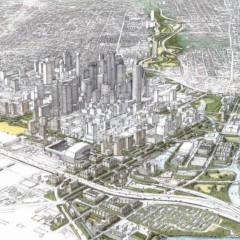Community organizers in Houston are now pushing for reform with a citywide petition, which by late May had over 75% of the 20,000 signatures needed to get on the ballot. This could lead to a referendum this November that would shake up how H-GAC works—with implications not only for how it doles out billions of dollars in transportation infrastructure, but also how the region envisions its future. H-GAC, in other words, may need to rethink how it balances the interests of the urban core with that of the suburbs and rural areas.
Who decides for the region?
“If there's anything that involves more than one city or more than one county, there's an excellent chance that we are involved in some way,” said H-GAC executive director, Chuck Wemple.
From disaster recovery to workforce development and most visibly, transportation infrastructure, the H-GAC is the regional agency tasked with coordinating it all across 13 counties, over 100 cities, and about 7 million people. The agency’s 37-member Board of Directors (and 28-member Transportation Policy Council, which passed the aforementioned resolution on I-45) —are composed of representatives for each of their component members.
Each county and home rule city with more than 25,000 people gets one vote (aside from Houston and Harris County, which get two each) on H-GAC’s board, as well as a vote for independent school districts, and two votes each for all general law cities and home rule cities with less than 25,000 people (as in they share the two votes).
In practice, this means the City of Houston and unincorporated parts of Harris County, which make up more than 57% of the population, have only 11% of the board’s votes, according to a recent analysis by January Advisors, a data science consulting firm based in Houston.
This has led to instances where Houston and Harris County are outvoted by the broader H-GAC board, most notably during the fight over expanding I-45 through the center of Houston, but also how federal funds for flood infrastructure were divvied up last year, where Houston got 2% of the funds despite being the epicenter of damage from Hurricane Harvey.
This is where a new petition campaign to change the structure of H-GAC launched by a local group called Fair For Houston comes in. If it were to get on the ballot in time for the Houston city elections this November and pass, the initiative would compel Houston to withdraw from H-GAC if it does not adopt proportional representation, meaning votes would be allocated based on a jurisdiction’s population. The gambit, organizers say, is to force H-GAC’s current directors to the negotiating table and reform its bylaws.
“Houston is the beating heart of the region,” said Molly Cook, an organizer with Fair for Houston. “But unfortunately, if you don't have the voting structure, you get outvoted by different interests around the region.”
From competing to coordinating
Regional cooperation in metropolitan areas was not really standardized until the federal government initiated the creation of the national interstate highway system in the 1950s and 1960s, when it mandated the creation of Metropolitan Planning Organizations (MPO). This required metropolitan areas with more than 50,000 people to coordinate the allotment of federal infrastructure dollars. At about the same time, Councils of Governments (COG), which often but do not always house MPOs, took off as a form of regional collaboration to distribute other federal dollars from agencies, such as the Department of Housing and Urban Development or Environmental Protection Agency.
“If you could boil down the purpose of a MPO or a COG: it is to organize regional collaboration and cooperation so that federal funds and local funds are planned for carefully and coordinated,” said Kyle Shelton, author of the book “Power Moves,” about the politics of Houston’s transportation system. (He’s also a former deputy director at the Kinder Institute for Urban Research.)
These regional groups came into being at a time when competition, not cooperation, was the norm in the Greater Houston area, Shelton said. The City of Houston was engaged in full swing annexations of many of its neighbors, such as Clear Lake.
“It wasn't exactly like ‘Kumbaya’ regional collaboration,” Shelton said. “All of these communities were competing with one another, like Pasadena and Houston over industrial uses and siting of plants that brought huge property taxes and brought jobs.”
It is in this environment of regional infighting—and state and the federal governments figuring out how to direct huge amounts of resources—that H-GAC, the council of government, was born in 1966. (The MPO was designated and housed at H-GAC in 1974, and is governed by its Transportation Policy Council).
Among the thousands of councils of government that exist in the US, H-GAC happens to be one of the biggest, most complex out of all of them, according to Wemple.
“Not every council of governments is also home to the MPO, the region's workforce board, the Economic Development District, and the region's Local Development Corporation for Small Business Administration–we have to have all those in there together,” he said.
Furthermore, H-GAC provides a forum for cities and counties to come together, collaborate and “lean into the hard, hard conversations that need to happen,” as Wemple said.
Changing the seats at the table
Those hard conversations often center around how to spend H-GAC’s budget, which includes about half a billion dollars in its annual budget (the vast majority of which goes to workforce development programs) as well how it manages long-term transportation planning, allocates state and federal transportation dollars, and divides disaster recovery funds among its members.
“There's never enough money to make everyone whole … and not everyone's always happy with the decision that we have, because sometimes things are, you know, divisive or hard to do,” Wemple said.
In addition to doling out federal resources, the regional council serves as a resource for fast-growing suburbs to supplement the build-out of major arterial roads, highways, and other infrastructure.
“I think what you see in H-GAC is that a lot of those outlying counties are basically articulating an argument that says, ‘We're growing, we're absorbing the growth of suburban development, and we need [funding] too,’” added Shelton.
Despite recent tensions funding allocation, a Harris County report found, for example, that the county was allocated more transportation dollars than any other member by a large margin. Likewise, a report cited by the Houston Chronicle suggested H-GAC’s allocations on workforce development were equitable.
“When I see statements like the Houston Galveston Area Council has bled Houston dry for years of federal state dollars–that's not true,” Wemple said.
But concerns about equity and proportionality go beyond strict funding allocations, and advocates for reform say there is a disconnect in terms of regional collaboration as overseen by the H-GAC in its current state.
“If you assume horizontal population growth, and if you assume that every single person who moves the Houston region is going to move with a car … that sort of leads down this path of what the city ends up actually looking like and how much concrete is poured,” Cook said.
To that end, advocates with the reform movement say regional governance shouldn’t be about picking winners and losers for federal dollars, but envisioning a broader, coordinated plan for how the region grows.
“A lot of the assumptions there may look good for some of these smaller suburban counties on paper in the short term, but in the long run, we know that they make they make us less safe, they make us more flood-prone, they stop the kind of conversations that can actually help the region improve,” said Evan Choate, Fair for Houston’s campaign manager.
“We have a real shot, and making a lasting structural change that will have lasting consequences for generations in Houston, in the entire area … is just very, very, very exciting." — Molly Cook
Those conversations would be possible if representation was proportional, the organizers say. While most regional governmental bodies in the US are not proportional, there are a few models, such as the regional council in the Seattle metropolitan area or the association of governments that covers the Phoenix area, which has a system that gives each member one vote based on population and another based on jurisdiction. In addition, a provision of the 2021 bipartisan infrastructure law requires any newly constituted MPO to adopt “equitable and proportional representation” when determining its membership.
Cook from Fair for Houston pointed out how their initiative is not a wholly new idea. In fact, both Harris County and H-GAC itself have looked into membership reforms in recent years; Wemple said H-GAC’s board decided to keep its current composition after some deliberation in 2021.
The calls for reforming H-GAC clearly highlights the importance of regional governance in one form or another in the Greater Houston area.
“I think that regional government is essential,” said Shelton. “Having a unit that can say, ‘Hey, it is our job, to convene you to have these conversations to create these shared plans to create these shared priorities,’ I think is really beneficial.’”
Wemple of H-GAC concurred: “If you want to travel fast, travel alone, if you want to travel far, travel together.”
How the Houston region travels together — and who decides where it goes — is the big question, and however the petition effort shakes out, it has started a conversation trying to address that.
“We have a real shot, and making a lasting structural change that will have lasting consequences for generations in Houston, in the entire area … is just very, very, very exciting,” Cook said.




